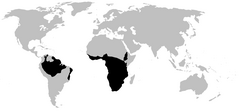Grzbietorodowate
| ||
| Pipidae[1] | ||
| J.E. Gray, 1825 | ||
 Przedstawiciel rodziny – Pipa carvalhoi | ||
| Systematyka | ||
| Domena | eukarionty | |
| Królestwo | zwierzęta | |
| Typ | strunowce | |
| Podtyp | kręgowce | |
| Gromada | płazy | |
| Rząd | płazy bezogonowe | |
| Podrząd | Mesobatrachia | |
| Rodzina | grzbietorodowate | |
| Typ nomenklatoryczny | ||
„Pipra Laurent” (= Pipa Laurenti, 1768) | ||
| Synonimy | ||
| ||
| Rodzaje | ||
zobacz opis w tekście | ||
| Zasięg występowania | ||
 | ||
Grzbietorodowate[35], żaby bezjęzyczne, bezjęzykowe, grzbietorody (Pipidae) – rodzina płazów z rzędu płazów bezogonowych Anura). W obrębie tej rodziny wyróżnia się 5 rodzajów i 33 gatunki.
Zasięg występowania
Rodzina obejmuje gatunki występujące w Ameryce Południowej na wschód od Andów i sąsiedniej Panamy oraz na południe od Sahary w Afryce[36].
Charakterystyka
Płazy te charakteryzują się brakiem języka i powiek. Mają ciało silnie spłaszczone, posiadają linię boczną. Rozmiar waha się od 3 do 18 cm. Palce stóp połączone błoną pławną. Niektóre gatunki należące do tej rodziny na trzech palcach tylnych kończyn posiadają twarde wypustki przypominające pazury.
Tryb życia
Prowadzą wodny tryb życia, żywiąc się bezkręgowcami wodnymi. Przy pożeraniu zdobyczy często pomagają sobie przednimi kończynami.
W okresie godowym grzbietorodowate wydają charakterystyczny cichy terkot (podobny do skrzypienia drzwi). Uzyskują go dzięki twardym płytkom krtaniowym.
Podział systematyczny
Do rodziny należą następujące rodzaje[36]:
- Hymenochirus Boulenger, 1896
- Pipa Laurenti, 1768
- Pseudhymenochirus Chabanaud, 1920 – jedynym przedstawicielem jest Pseudhymenochirus merlini Chabanaud, 1920
- Xenopus Wagler, 1827
Uwagi
- ↑ Rodzaj typowy: Dactylethra Cuvier, 1829 (= Xenopus Wagler, 1827).
- ↑ Rodzaj typowy: Astrodactylus Hogg, 1838 (= Asterodactylus Wagler, 1827 (= Pipa Laurenti, 1768)).
- ↑ Rodzaj typowy: Xenopus Wagler, 1827.
- ↑ Rodzaj typowy: Hymenochirus Boulenger, 1896.
- ↑ Rodzaj typowy: Silurana J.E. Gray, 1864 (= Xenopus Wagler, 1827).
Przypisy
- ↑ Pipidae, [w:] Integrated Taxonomic Information System [online] (ang.).
- ↑ J.E. Gray. A Synopsis of the genera of Reptiles and Amphibia, with a description of some new species. „Annals of Philosophy”. New Series. 10, s. 214, 1825 (ang.).
- ↑ L.J.F.J. Fitzinger: Neue classification der reptilien nach ihren natürlichen verwandtschaften: nebst einer verwandtschafts-tafel und einem verzeichnisse der reptilien-sammlung des K. K. zoologischen museum’s zu Wien. Wien: J. G. Heubner, 1826, s. 37. (niem.)
- ↑ J.E. Gray. Synopsis generum reptilium et amphibiorum. „Isis von Oken”. 22, s. 203, 1829 (łac. • niem.).
- ↑ W.F. Hemprich: Grundiss der Naturgeschichte für höhere Lehrenstatlen. Wyd. 2 (Zweite Ausflage). Berlin: August Rüder, 1829, s. xix. (niem.)
- ↑ J.G. Wagler: Natürliches System der Amphibien, mit vorangehender Classification der Säugethiere und Vögel. Ein Beitrag zur vergleichenden Zoologie. München, Stuttgart und Tübingen: In der J.G. Cotta’scchen Buchhandlung, 1830, s. 131. (niem.)
- ↑ A.F.A. Wiegmann: Klasse Amphibien. Amphibia. W: A.F.A. Wiegmann & J.F. Ruthe (red.): Handbuch der Zoologie. Berlin: Luederitz, 1832, s. 200. (niem.)
- ↑ J.J. von Tschudi: Classification der Batrachier mit Berücksichtigung der fossilen Thiere dieser Abtheilung der Reptilien. Neuchâtel: Petitpierre, 1838, s. 26. (niem.)
- ↑ a b H.R. Hogg. On the classification of the Amphibia. „Annals of Natural History”. 1, s. 152, 1838 (ang.).
- ↑ W. Swainson: Natural History of Fishes, Amphibians & Reptiles, or Monocardian Animals. Cz. 2. London: Longman & Co., 1839, s. 88. (ang.)
- ↑ Ch.L. Bonaparte. Amphibia Europaea and systema nostrum vertebratorum ordinata. „Memoria. Reale Accademia delle Scienze di Torino”. Serie Seconda. 2, s. 394, 1840 (łac.).
- ↑ A.M.C. Duméril & G. Bibron: Erpétologie générale, ou, Histoire naturelle complète des reptiles. T. 8. Paris: Roret, 1841, s. 761. (fr.)
- ↑ Anonim: Second Room. W: Synopsis of the Contents of the British Museum. Wyd. Forty-fourth edition. London: Trustees of the British Museum, 1842, s. 112. (ang.)
- ↑ L.J.F.J. Fitzinger: Systema reptilium. Fasciculus primus, Amblyglossae. Vindobonae: Braumüller et Seidel, 1843. (łac.)
- ↑ Ch.L. Bonaparte: Conspectus Systematum. Herpetologiae et Amphibiologiae. Wyd. Editio altera reformata. Lugdini Batavorum: E. J. Brill, 1850, s. 1 p. (łac.)
- ↑ E. Hallowell. Notice on a collection of reptiles from the Gaboon country, West Africa, recently presented to the Academy of Natural Sciences of Philadelphia, by Dr. Henry A. Ford. „Proceedings of the Academy of Natural Sciences of Philadelphia”. 9, s. 65, 1857 (ang.).
- ↑ A.C.L.G. Günther: Catalogue of the Batrachia Salientia in the Collection of the British Museum. London: Taylor and Francis, 1858, s. xvii. (ang.)
- ↑ J. Leunis: Synopsis der drei Naturreiche. Ein handbuch für höhere lehranstalten und für alle, welche sich wissenschaftlich mit der naturgeschichte der thiere beschäftigen wollen. Mit vorzüglicher Berücksichtigung der nützlichen und schädlichen Naturkörper Deutschlands. Zweite Auflage. Cz. 1: Zoologie. Hannover: Hahnsche buchhandlung, 1860, s. 335. (niem.)
- ↑ L. Fitzinger. Die Ausbeute der österreichischen Naturforscher an Säugethieren und Reptilien während der Weltumsegelung Sr. Majestät Fregatte Novara. „Sitzungsberichte der Kaiserlichen Akademie der Wissenschaften. Mathematisch-Naturwissenschaftliche Classe”. 42, s. 416, 1861 (niem.).
- ↑ C.A. Bruch. Beiträge zur Naturgeschichte und Classification der nackten Amphibien. „Würzburger Naturwissenschaftliche Zeitschrift”. 3, s. 221, 1862 (niem.).
- ↑ A.H.A. Duméril. Catalogue méthodique de la collection des batraciens du Muséum d’Histoire Naturelle de Paris. „Mémoires de la Société Impériale des Sciences Naturelles de Cherbourg”. 9, s. 300, 1863 (fr.).
- ↑ C.K. Hoffmann: Klassen und Ordnungen der Amphibien wissenschaftlich dargestelldt in Wort un Bild. W: H.G. Bronn (red.): Die Klassen und Ordnungen des Thier-Reichs wissenschaftlich dargestelldt in Wort und Bild. Cz. 6. Leipzig und Heidelberg: C. F. Winter, 1878, s. 598. (niem.)
- ↑ G.A. Boulenger. Reptilia and Batrachia. „Zoological Record”. 18, s. 13, 1893 (ang.).
- ↑ W.C.H. Peters: Naturwissenschaftlich Reise nach Mossambique auf befehl Seiner Mäjestat des Königs Friedrich Wilhelm IV in den Jahren 1842 bis 1848 ausgeführt. Cz. 3: Zoologie. Berlin: G. Reimer, 1882, s. 179. (niem.)
- ↑ a b F.K. Knauer: Naturgeschichte der Lurche. (Amphibiologie.) Eine umfassendere Darlegung unserer Kenntnisse von dem anatomischen Bau, der Entwicklung und systematischen Eintheilung der Amphibien sowie eine eingehende Schilderung des Lebens dieser Thiere. Wien: A. Pichler’s witwe & Sohn, s. 103. (niem.)
- ↑ E.D. Cope. Batrachia of North America. „Bulletin of the United States National Museum”. 34, s. 248, 1889 (ang.).
- ↑ I.B.J. Sollas. Reptilia and Batrachia. „Zoological Record”. 42 (1), s. 37, 1906 (ang.).
- ↑ a b c S.J. Bolkay. Osnove Uporedne Osteologije Anurskih Batrahija. „Glasnika Zemaljskog Muzeja u Bosni i Hercegovini”. 31, s. 348, 1919 (bośn.).
- ↑ a b c M.M. Metcalf. The opalinid ciliate infusorians. „Bulletin of the United States National Museum”. 120, s. 391, 1923 (ang.).
- ↑ G.K. Noble: The Biology of the Amphibia. New York and London: McGraw-Hill, 1931, s. 489. (ang.)
- ↑ D.C. Cannatella & L. Trueb. Evolution of pipoid frogs: Intergeneric relationships of the aquatic frog family Pipidae (Anura). „Zoological Journal of the Linnean Society”. 94 (1), s. 32, 1988. DOI: 10.1111/j.1096-3642.1988.tb00880.x (ang.).
- ↑ a b A.M. Báez & L.A. Pugener. Ontogeny of a new Palaeogene pipid frog from southern South American and xenopodinomorph evolution. „Zoological Journal of the Linnean Society”. 139 (3), s. 454, 2003. DOI: 10.1046/j.1096-3642.2003.00085.x (ang.).
- ↑ a b A. Dubois. Amphibia Mundi. 1.1. An ergotaxonomy of Recent amphibians. „Alytes”. 23 (1), s. 8, 2005 (ang.).
- ↑ A.J. Bewick, F.J.J. Chain, J. Heled & B.J. Evans. The pipoid root. „Systematic Biology”. 61 (6), s. 913–926, 2012. DOI: 10.1093/sysbio/sys039 (ang.).
- ↑ Praca zbiorowa: Zwierzęta: encyklopedia ilustrowana. Warszawa: Wydawnictwo Naukowe PWN, 2005, s. 431. ISBN 83-01-14344-4.
- ↑ a b D. Frost: Pipidae Gray, 1825 (ang.). W: Amphibian Species of the World 6.0, an Online Reference [on-line]. American Museum of Natural History. [dostęp 2020-02-02].
Media użyte na tej stronie
Autor: (of code) -xfi-, Licencja: CC BY-SA 3.0
The Wikispecies logo created by Zephram Stark based on a concept design by Jeremykemp.
Autor: Renato Augusto Martins, Licencja: CC BY-SA 4.0
Sapo - pipa - Pipa carvalhoi - Espécie aquática encontrada em lagos e lagoas.


